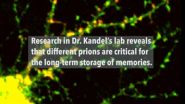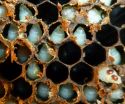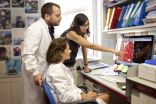These data form the basis of vaccine regimens that are now being evaluated in an international phase 1/2a clinical trial for safety and immunogenicity in healthy, HIV-uninfected volunteers.
"Despite great progress in HIV treatments, HIV remains one of the greatest global health threats of our time with millions continuing to be infected each year. Our ultimate goal is to develop a vaccine that prevents HIV in the first place. By Janssen collaborating with multiple stakeholders on new tools, we hope one day to help eradicate HIV," said Paul Stoffels, M.D., Chief Scientific Officer and Worldwide Chairman, Pharmaceuticals, Johnson & Johnson.
The pre-clinical study published today evaluated the protective efficacy of a "prime-boost" vaccine approach, which leverages AdVac® Technology from Janssen and a trimeric envelope protein boost. Non-human primates (NHP) were first given an adenovirus serotype 26 (Ad26) vectored vaccine to prime the immune system, and then a boost of a purified HIV envelope protein intended to enhance the immune system over time. This approach is intended to increase both the magnitude of the immune response and the overall protection against subsequent viral challenge. A heterologous prime-boost vaccine regimen using a similar AdVac® vector, along with an MVA-based vector, is being used in Janssen's preventative Ebola candidate vaccine regimen that is currently in Phase 1 human clinical studies.
Pre-Clinical Results Lead to Human Study The study results show that the investigational prime-boost vaccine regimen provided complete protection from becoming infected with simian immunodeficiency virus (SIV), a virus similar to HIV that infects NHPs, in half of the vaccinated NHPs (n=12) against a series of six repeated challenges. This work also demonstrates that there is a strong link between the protective ability of the vaccine regimen and the number of antibody functions to fight the virus, so called polyfunctionality, which supports the continued development of the vaccine regimen for human use. These results have previously been presented at several international congresses.
"We are very encouraged by the results of this preclinical HIV vaccine study, and the findings lead to a clear path forward for evaluating this HIV vaccine candidate in humans," said lead author Dan H. Barouch, MD, PhD, Director of the Center for Virology and Vaccine Research at BIDMC and Professor of Medicine at Harvard Medical School.
The phase 1/2a study (HIV-V-A004) is currently enrolling 400 volunteers in the United States and Rwanda to evaluate heterologous prime-boost regimens, with sites in South Africa, Uganda and Thailand opening soon. Ongoing phase 1 clinical studies have been evaluating the safety and immunogenicity of different components which are included in the regimens to be used in this study.
The HIV-1 and Ebola AdVac-based vaccine regimens, along with Janssen's investigational candidate inactivated polio vaccine, utilize Janssen's PER.C6® production cell line technology which has the potential to reduce costs by increasing vaccine production at lower volumes, to develop, manufacture and, upon approval, commercialize vaccines.
INFORMATION:
Since 2005, Crucell Holland B.V. has been participating in the National Institutes of Health (NIH) supported Integrated Preclinical/Clinical AIDS Vaccine Development (IPCAVD) program under grants AI066305. AI078526, AI096040 to evaluate HIV-1 vaccine candidates to address the epidemic. The pre-clinical study was supported by grants from the NIH: AI060354; AI078526; AI0080280; AI084794; AI095985; AI096040; AI102660; AI102691; OD011170; HHSN261200300001E, as well as funding from the Bill & Melinda Gates Foundation, and the Ragon Institute of Massachusetts General Hospital, MIT, and Harvard.
About Johnson & Johnson
Caring for the world one person at a time...inspires and unites the people of Johnson & Johnson. We embrace research and science - bringing innovative ideas, products and services to advance the health and well-being of people. Our approximately 127,000 employees at more than 265 Johnson & Johnson operating companies work with partners in health care to touch the lives of over a billion people every day, throughout the world.
About Crucell
Crucell Holland B.V. is one of the Janssen Pharmaceutical Companies of Johnson & Johnson, and is focused on research, development and production of vaccines that prevent and/or treat infectious diseases. We have a broad development pipeline, with several product candidates based on our unique AdVac® and/or PER.C6® production technology.
About the Janssen Pharmaceutical Companies of Johnson & Johnson
At Janssen, we are dedicated to addressing and solving some of the most important unmet medical needs of our time in infectious diseases and vaccines, oncology, immunology, neuroscience, and cardiovascular and metabolic diseases. Driven by our commitment to patients, we develop innovative products, services and healthcare solutions to help people throughout the world.
Cautions Concerning Forward-Looking Statements
This press release contains "forward-looking statements" as defined in the Private Securities Litigation Reform Act of 1995 regarding product development. The reader is cautioned not to rely on these forward-looking statements. These statements are based on current expectations of future events. If underlying assumptions prove inaccurate or known or unknown risks or uncertainties materialize, actual results could vary materially from the expectations and projections of Crucell Holland B.V. and/or Johnson & Johnson. Risks and uncertainties include, but are not limited to: challenges and uncertainties inherent in new product development, including uncertainty of clinical success and obtaining regulatory approvals; competition, including technological advances, new products and patents attained by competitors; challenges to patents; changes to applicable laws and regulations, including global health care reforms; and trends toward health care cost containment. A further list and description of these risks, uncertainties and other factors can be found in Johnson & Johnson's Annual Report on Form 10-K for the fiscal year ended December 28, 2014, including in Exhibit 99 thereto, and the company's subsequent filings with the Securities and Exchange Commission. Copies of these filings are available online at http://www.sec.gov, http://www.jnj.com or on request from Johnson & Johnson. None of the Janssen Pharmaceutical Companies or Johnson & Johnson undertakes to update any forward-looking statement as a result of new information or future events or developments.



